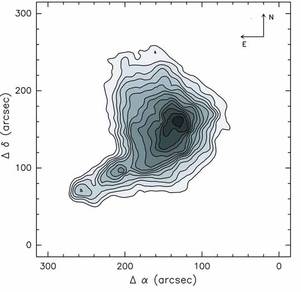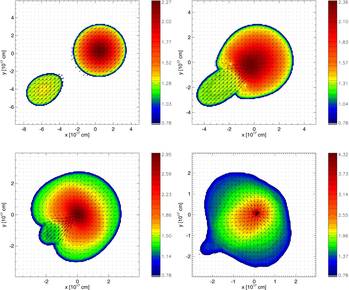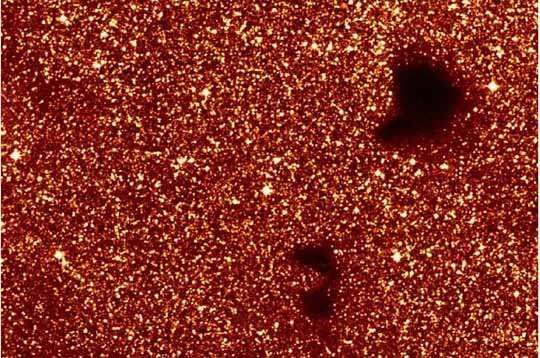Barnard 68 delivers new findings on the formation of stars
07.05.2009 —
Astronomers have had a rough idea of how stars form in the universe for decades: Giant interstellar gas clouds travel through the Milky Way and other spiral galaxies. As they move they condense more and more due to the effect of their own gravitation until both density and temperature are high enough in certain areas to initiate nuclear fusion. Hundreds or thousands of stars thus form from a single huge cloud. Despite the fact that this theory has strongly established itself among astronomers, there are still so many questions that remain unanswered on numerous details of the formation of stars.
The Munich astrophysicist Andreas Burkert of the Excellence Cluster Universe and his colleague Joao Alves of the Spanish Calar Alto Observatory have gained new insight into the final collapse phase of a molecular cloud (Astrophysical Journal, 695:1380-1314, 20 April 2009). The researchers have discovered that the collision of two essentially stable gas clouds may be responsible for the decisive „kick“ needed to trigger the final collapse.
One of the closest star formation regions in our cosmic neighbourhood is the Pipe Nebula in the constellation Ophiuchus, which can be observed in Central Europe from spring to autumn. The nebula represents a complex of numerous so-called Bok globules. These refer to spherical, cold gas clouds, whose masses are in the region of 0.1 to 10 times the mass of the sun. Astronomers have long considered such globules to be the direct precursor of young stars. One of them is the cloud Barnard 68 (B68), which is approx 0.2 light years in size and 400 light years away. As a result of its close proximity to the earth, B68 has attracted the interest of astronomists for a long time. To date no other gas cloud has been studied so intensely. From the weakening of the infrared light of stars hidden behind the cloud, it was possible to ascertain with high precision the mass and the inner structure of the compact cloud.
 Figure 1: Map of dust column density of Barnard 68 (Alves et al.)
Figure 1: Map of dust column density of Barnard 68 (Alves et al.)
Andreas Burkert und Joao Alves suggest that B68 is in fact in a very early state of instability and is just about to begin to collapse. They claim to have discerned the reason for this in a small structure located in the southeast region of the cloud: Pictures of the cloud clearly show an independent globule which is approximately 10 times lighter and is evidently about to collide with B68.
In order to prove their theory, both astrophysicists have now simulated the scenario with the help of a SGI-ALTIX super computer of the Technische Universität München. They fed the computer with the coordinates of two spherical lumps which are 1 light year apart from each other with 2 and 0.2 solar masses respectively and assigned the individual simulation particles typical speed patterns which correspond to those that arise in the theoretical models. They adjusted the inner structures of the objects to the natural example of Barnard 68 and its neighbour. Then they followed the development of the system with the help of a numerical algorithm, which calculated the gas movement under the influence of gravity in thousands of tiny steps in time.

Figure 2: Snapshots of the simulation of a small globule merging with a big gas cloud
As was expected, the smaller globule of the two changed its structure first to penetrate the larger globule after about 1.7 million years of „computer time“ at a speed of 370 meters per second. The internal structure of the united system corresponded exactly to the internal structure of the real Barnard cloud. In their model, the researchers also found the gas flow triggered by the impact pressure of the collapsing cloud, which they had observed flowing from the globule in the direction of the earthly observers. During the further course of the simulation, the previously stable system did in fact go out of balance and began to collapse and generated extremely high densities in its centre – the conditions for the formation of a star seem to be fulfilled.
In several simulations of this kind, the researchers varied the physical parameters of the globules and were able to deduce from them, under which circumstances the fusion of two gas clouds leads to the subsequent collapse. If the calculations of Burkert and Alves are correct, a new star similar to the sun will shine in our direct cosmic neighbourhood within the next 200,000 years, in whose vicinity planets could also form.






